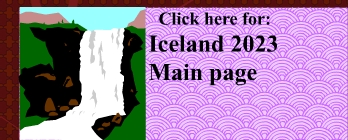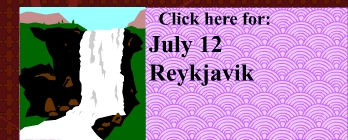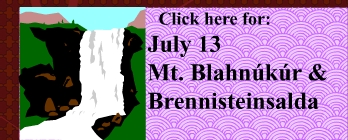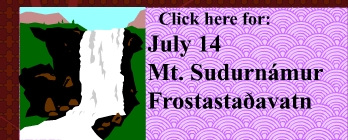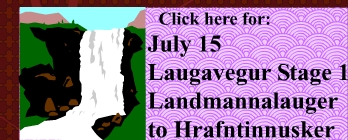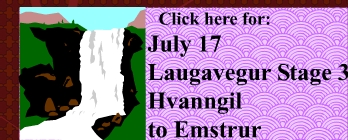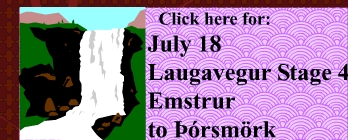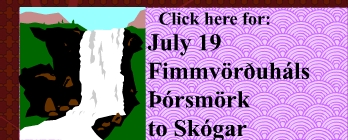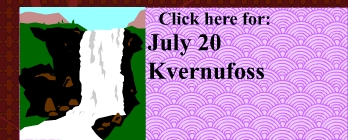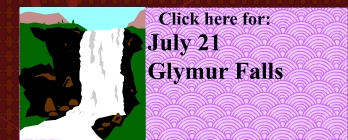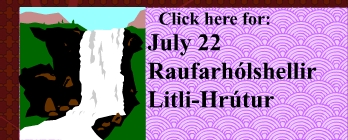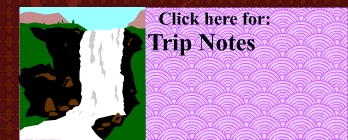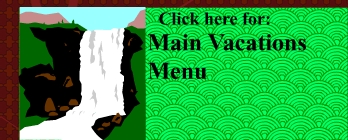

On stage one of the Laugavegur, we hiked into the Torfaj÷kull caldera to Hrafntinnusker. For stage two, we hiked out of the caldera, and down its steep south rim, making our way to the ┴lftavatn valley and subsequently over to Hvanngil.
Stage 2 begins by striking out across the caldera, which is filled with rolling hills split by ravines. Some of the ravines have steep sides, requiring careful negotiation down the slope and then a short tough climb up the other side. I saw more than one hiker simply siding down the trail on their fanny. I was glad I had my hiking poles. I wondered how the marathon runners the day before dealt with these ravines - probably they just charged down in giant steps.
It started to rain lightly, but hard enough that we stopped and put our pack covers on. That seemed to appease the rain gods, because the rain drops then let up. But it was still cold and windy, I was glad to be wearing gloves.
There was plenty of geothermal activity to see along the way; fumaroles sending steam up out of vents. We had to cross patches of snow, but it was well packed but not icy so it was not necessary to put on our microspikes. The wind intensified - at one point it ripped my pack cover off and sent it sailing toward the edge of a deep ravine - I thought the cover was gone, but some quirk held the cover to the ground just before the slope got really steep, so I scurry-slid down the hill and pinned the cover with my hiking pole. I was able to retrieve the pack cover and clamber back up to the Laugavegur. That's about the worst thing that happened on this entire trip - so it was an excellent trip!
Some climbing is required as the trail heads south until one big ridge is surmounted and we stood on the J÷kultungur ("Glacier Tongue") plateau. Looking back, I could still see the H÷skuldsskßli hut. This was the highest elevation of the day, now it would be a long steep downhill as we exited the caldera. Just before descending, there is an impressive view of the ┴lftavatn (Swan Lake) valley and the distant glaciers of Eyjafjallaj÷kull and Mřrdalsj÷kull.
Once we reached the valley floor, we had our first river crossing - a wade across the GrashagakvÝsl (Google translate says the name means "Grass Meadow Branch" ). The water was only shin deep, and though cold, the river was not wide.
Strong winds were blowing at ┴lftavatn. A dirt road leads to the hut, and the wind was picking up dirt from that road and creating a dust storm around the hut. It was about 2 PM when we stopped at the Volcano Huts restaurant (we didn't start hiking this day until about 9 AM) for our hot lunch of mushroom soup, bread and a salad of lettuce, cucumbers and tomatoes. We spent perhaps an hour resting here. I picked up the two packed lunches that I had ordered - they were my dinners for the next two nights.
It is a short easy hike from ┴lftavatn to Hvanngil (the name might mean Golden Valley, though one webpage said it means Angel Valley); though we had to remove our boots and wade across another shallow river - the Brat■ßlskvÝsl ("Bratthal Branch"). I liked the Hvanngil hut - it was clean and nice, with new showers and flush toilets. Surprisingly, the six of us were the only people to stay in the Hvanngil hut that night, other than one other woman who was hiking solo. We heard from the warden that more people would be showing up later because ┴lftavatn was full, but if they did arrive, they must have decided to camp.
After an early dinner, Paul and Melanie and I decide to hike the Hvanngilskausar ridge. The warden estimated it would take 2 1/2 to 3 hours to do the full loop - we left at 5:30 PM and were back at 8 PM. The start of this hike was not promising - a steep trail goes straight up the ridge. We were buffeted by very strong winds, making it difficult simply to stand up. But eventually we reached the crest and the wind died down considerably. From up on the ridge, we had good views in all directions. We could see down into Hvanngil valley. We watched huge clouds of dust driven by strong winds across the black desert of MŠlifellssandur (Google translate says this means 'Measured Sand'). We had a good view of the Stˇras˙la ('Great Column') peak, but the evening light was behind it, so my photographs were not impressive.
The white stakes led us over several rounded peaks - sometimes climbing higher through rocky summits. A few times we had to hunt for the stakes to determine which way to proceed. Overall the trail wasn't hard after the initial climb, the descent had a steep section but nothing like the path that we had come up on. Once we reached the Hvanngil valley floor, the stroll back to the hut was easy.
Below is the map of stage 2 of the Laugavegur. The trail crosses the Torfaj÷kull caldera, gradually climbing, until it reaches the J÷kultungur plateau. Then it is all downhill into the ┴lftavatn valley. A couple of shallow river crossings later (after a nice stop at ┴lftavatn) and the day ends at Hvanngil.

I took a picture of this hiking trail map that was posted on the side of the Hvanngil hut. It depicts the Laugavegur trail in green, and the dirt roads in brown. The loop trail up to the Hvanngilshausar ridge is shown as a solid dark blue line. The hike we did the next morning in the Hvanngil gorge is shown as a dotted blue line. The rivers BlßfjallakvÝsl and KaldaklofskvÝsl are shown in light blue lines. The grey terrain demarks the MŠlifellssandur volcanic desert.














































